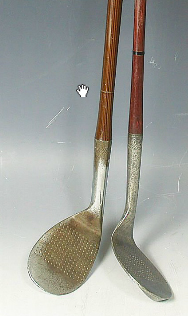A Wedge is a Wedge is a Wedge!
By Jim McNaney
Recently I was having a conversation with a long time PGA Professional and dear friend. We started looking at a collection of old clubs he had in his office. One of them was a Wilson Sarazen Sand Wedge. I was fascinated by the elegance of the design. Holding it in my hand, I could feel the extra weight in the head. That extra weight made it feel like I could get out of even the deepest bunkers at St. Andrews with no trouble. That sense of confidence was intoxicating.
Much to my surprise, my longtime friend said he thought that club was one of the worst things to happen to golf and it should not have been allowed to be used in competition.
I was shocked.
I don’t know why I was shocked. I know my friend likes things to be traditional. I know he would rather see things the way they used to be; and, for the most part, I do to, but not allow the sand wedge? I get that golf is supposed to be a game of skill but at what point do we say, “You know…I can use all the help I can get.”
For those that don’t know, a sand wedge is not a new invention. Gene Sarazen invented the club in 1935. Prior to that, extracting your ball out of a deep bunker required hands of a magician. Sarazen developed a club that would glide through the sand making it much easier to swing through fully and have the ball land softly on the green.
He accomplished this in two ways. First he added loft. Most sand wedges come with 55 or 56 degrees of loft. Second, he created a cambering on the sole he called bounce. Bounce was the critical difference in his design.
Bounce is defined as the degree of angle from the leading edge of the club head to the lowest point on the sole. It is NOT the width of the sole.
Over the years there has been debate over how much or how little bounce should a player have in their sand wedge. Until recently, determining the right amount of bounce was trial and error at best. More likely, it was pure luck that you picked the right wedge for your game. Different swings require different bounce.
Over the last 30 years, manufacturers have taken Sarazen’s sand wedge and added more options. Wedges with lofts ranging from 46 degrees all the way up to 64 degrees are available with more sole and bounce configurations than I can count.
This drives my friend nuts.
“They’re taking the skill out of the game.” He argues.
I answer, “What about the less-skilled player. They want to play the game AND enjoy it, not get beat up because they can’t move the ball forward or get it out of the bunker?”
You see, I teach people to play golf. I get paid to help people learn the techniques required to play golf with some level of competence. It is my responsibility to help people play better and sometimes that means teaching them to have the right equipment in their bag.
I can’t even count the number of times I’ve looked in a student’s bag over the years and found that they do not have the right wedge for them, nor do they have enough wedges. Many times, when they do have a wedge or two, it’s one they’ve picked up at Wal-Mart or from the lost and found bin at the course. Heck, some don’t even have a sand wedge and then they come to me for lessons because they can’t ever get out of the sand.
I think the main reason people don’t have enough wedges (or the correct wedges) is a lack of education. Until recently, most people did not know what options were available to them. Wedges were an afterthought or “something that just came with the set.” With that in mind, companies like Cleveland, Callaway and Titleist have started to incorporate full wedge fittings into their full fitting process. Not only do these fitting help determine the right lofts for your game, but the right bounce and sole configurations for your swing.
To this advancement I say THANK YOU!
In my mind this is one of the best things to happen to club fitting over the last 10 years. I am convinced that players with get better at the short game if they have the wedges that fit their swing the best. All of the different problem shots players’ face around the greens requires either more skill or more options.
Unlike my friend, I believe it is easier to learn one chipping or pitching technique and change clubs based on the shot rather than learning how to hit a ton of shots with one club. Having multiple wedges allows a player to have a basic short game swing yet be able to play out of multiple situations.
Is that “taking the skill out of the game?” I don’t think so. You still need a basic technique but you don’t have to be Seve Ballesteroes.
My opinion…get fit for your wedges. Find out what you need and add them to your bag. You will be happy you did.



